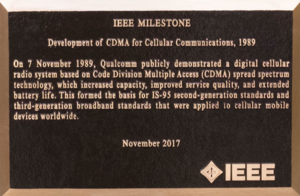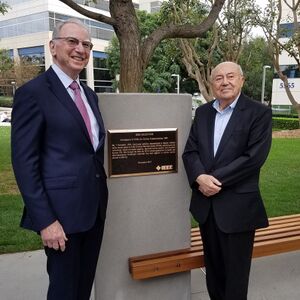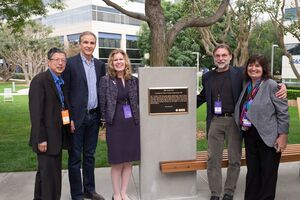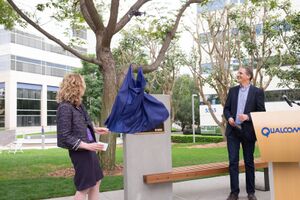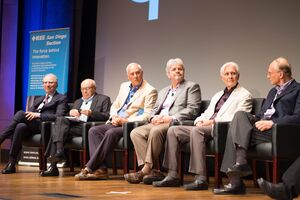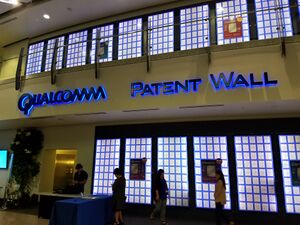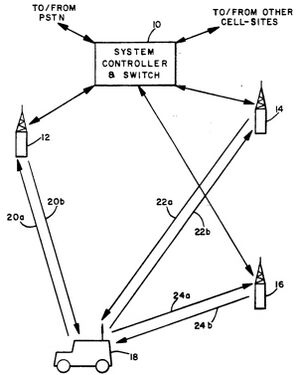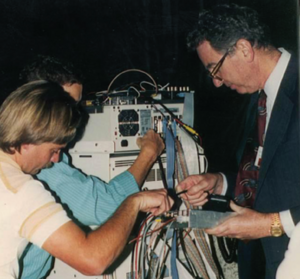Milestones:Development of CDMA for Cellular Communications, 1989
Title
Development of CDMA for Cellular Communications, 1989
Citation
On 7 November 1989, Qualcomm publicly demonstrated a digital cellular radio system based on Code Division Multiple Access (CDMA) spread spectrum technology, which increased capacity, improved service quality, and extended battery life. This formed the basis for IS-95 second-generation standards and third-generation broadband standards that were applied to cellular mobile devices worldwide.
Street address(es) and GPS coordinates of the Milestone Plaque Sites
Qualcomm, Inc., 5775 Morehouse Dr., San Diego, CA 92121 US (GPS: 32.895591, -117.196248)
Details of the physical location of the plaque
Mounted in a concrete pillar that adjoins a wooden seating area, in front of the lawn just outside of the main lobby of the 10-story Qualcomm, Inc. headquarters Building (known as Bldg. N)
How the plaque site is protected/secured
The site is fully accessible to the public, and has 24/7 security.
Historical significance of the work
First Generation (1G) Analog Cellular Networks In the 1980s, mobile systems managed network access by assigning specific frequency channels to users. In the first generation of cellular (now known as “1G”), one user would occupy a single channel when making a cellular call, thus limiting the capacity of a given cell to the number of channels available within a cell site.
Second Generation (2G) Digital Cellular Networks In the late 1980s, the ability to service multiple subscribers within a single channel was accomplished in the second generation of cellular (“2G”) with a technology called time division multiple access (TDMA). In this technique, a radio channel was divided into time slots and assigned to multiple users. Within an assigned time slot, only a single user utilized the channel. However, the switching across time slots was done so quickly that users didn’t notice that the communication channel was shared.
In the North American 2G standard (called D-AMPS, or Digital AMPS), three users occupied a 30 KHz channel. GSM (Global System for Mobile Communications, originally Groupe Spécial Mobile), the European 2G technology initiated by the European Telecommunications Standards Institute (ETSI) standards body, also utilized TDMA but with a wider 200 KHz channel supporting up to eight users.
Additionally, because neighboring cells were on different frequencies (to prevent interference), a “hard” switch in frequencies occurred when moving from one cell to the next. This hard switch (known as a hard handover) caused intermittent dropped calls and problems with users “ping ponging” between base stations. In addition, as demand for mobile services continued to grow, it become clear that the capacity gains of the TDMA approach would not be able to scale to accommodate future growth.
Code Division Multiple Access (CDMA) CDMA, which was historically used for military communications, is a technology in which signals are spread over a frequency using a unique code for each signal, and the resulting low-power signals travel over the same frequency at the same time. At the receiver, the signal is reconstructed using the same unique code that was used for spreading. The desired signal is separated out from the rest of the signals, which are received, but being received as background noise they can be effectively minimal until a certain level.
When they were in use, CDMA networks utilized all the available spectrum by spreading user traffic across a channel, reducing the traditional guard bands frequency required with TDMA. Multiple users were thus able to communicate simultaneously over the same frequency.
As dead time (silence) makes up over half of a typical telephone conversation, CDMA’s suppression of the transmission of silence greatly increased energy and capacity efficiency. Because CDMA was a spread spectrum technology, system capacity directly benefited from efficiencies realized within the communication channel.
Variable rate coding (VRC) introduced four rates of transmission, (9600, 4800, 2400, and 1200 bits per second (bps)), allowing a cellular device to throttle the rate of transmission depending on the level speech activity. [2] Dead time would be transmitted at 1200 bps, greatly reducing the power and processing required for transmit and receive. Overall capacity increased by a factor of 3 with VRC. Additionally, the suppression of background noise (common in cellular communications at the time) greatly improving call quality. [3]
CDMA’s Impact on 3G CDMA’s benefits over TDMA included fewer dropped calls during handovers, higher capacity and bandwidth, improved voice clarity, lower device costs and longer battery life. Because of all of these benefits and more, all third generation cellular technical standards (“3G”) were based on the CDMA technology pioneered by Qualcomm. 3G ushered in the era of power efficient, low cost smartphones with internet access speeds that rivaled typical home internet access speeds.
CDMA thus created a technology foundation whose benefits have spanned many aspects of society, both economically and socially. Over half of the population now owns a mobile device, providing internet access to much of the world’s underserved communities. CDMA was the catalyst of this change.
As of 2016, there were around 3 billion 3G devices worldwide. This is shown, for example, in a chart showing 2G, 3G and 4G LTE presence in the world over time that can be found in a Working Document created for the European Union's European Parliament here: http://eur-lex.europa.eu/legal-content/en/TXT/?uri=CELEX:52016SC0306 (on p. 8 of the PDF here: http://eur-lex.europa.eu/legal-content/EN/TXT/PDF/?uri=CELEX:52016SC0306&from=en).
Obstacles (technical, political, geographic) that needed to be overcome
Challenges of industry acceptance Led by Irwin Jacobs and Andrew Viterbi, Qualcomm entered the cellular industry, leveraging expertise in digital wireless technologies that at the time were applied only to satellite communications for military and transportation use cases. Although these digital wireless technologies had been around for a while, very few people possessed the knowledge and the skill sets to implement it in commercial systems. Despite resistance from the mobile industry that was largely already invested in TDMA, Qualcomm proposed a more radical solution to the capacity problem using a spread spectrum technology called CDMA.
In its first ten years of existence, Qualcomm’s CDMA was very disruptive and controversial within a cellular industry dominated by a few powerful players. [4] The Qualcomm proposal disrupted the mobile industry because it was so unconventional when compared with TDMA. Many in academia and industry said Qualcomm’s solution was downright impossible, and that there were fundamental problems that couldn’t be resolved. It was claimed that the technology was too complex for commercialization, that it would not scale, that the stated cost advantages were simply false, and/or that the technology was simply too late. [5]
Media outlets including the Wall Street Journal and the New York Times reported on the CDMA controversy. The Wall Street Journal claimed “There is also a worst-case possibility: that CDMA doesn't work on the massive scale required, an outcome that would inflict billions of dollars of losses on the equipment makers and network operators that have bought into Dr. Jacobs's promises.” [6]
Despite a large portion of the industry pushing to continue forward with the existing standards, CDMA’s many benefits including much greater voice capacity over 1G and TDMA became clear. Qualcomm’s perseverance led to CDMA becoming the Telecommunications Industry Association standard TIA/EIA/IS-95 in 1995. More commonly known at the time as cdmaOne, this was a critical step in the worldwide adoption of CDMA.
Technical Challenges - Public Demonstration of CDMA In the Spring of 1989, Qualcomm executives signed a contract with Regional Bell Operating Company (RBOC) Pacific Telesis to provide an industry demonstration of CDMA technology. This contract gave Qualcomm six months to prove to the industry that CDMA was a viable technology.
During this time period, Qualcomm engineers had to complete their prototype design of base stations and mobile phones, along with software that would run throughout the system. New equipment then had to be built and integrated, field tested and debugged. Pre-demo tests relied on the resources and cooperation of Pacific Telesis.
In an October 1989 employee newsletter, Qualcomm CEO Irwin Jacobs wrote, “…a large team is now working day and night to complete several mobile phone prototypes and cell site equipment. [If] we can then demonstrate the quality of our cellular telephone as we drive around the area, the product has a very large potential for our company.”
A total of eight stations were built, with the intent of running the demonstration with one mobile station in a test van with two base stations. The five other stations were used for lab testing and as spares. Other users on both the forward link and the reverse link were simulated with Gaussian Noise generators.
Commercial GPS receivers provided transmission timing of the two base stations. However, these early-model, GPS timing receivers had reliability issues, and the GPS navigational satellite constellations were not fully deployed at the time of the demonstration.
The demonstration area was the Sorrento Mesa and Clairemont neighborhoods of San Diego, California. A GPS Calibration Point was established approximately equidistant from each base station, and the van with the mobile station had to go to this spot to verify the correct timing of the two base stations.
The system was not entirely operational when invitations for the live demonstration were sent to industry members about one month in advance of the event. On November 7, 1989 (the first day of the demo), one GPS timing receiver lost sync with the GPS satellites, and Qualcomm CEO Irwin Jacobs had to stall his talk to the approximately 50 attendees while engineers waited for it to recover. The receiver had not fully recovered when the driving demo started, and it became fully operational only moments before the first base station hand-off occurred. However, the equipment worked without failure for the rest of the drive tests during the five days of the industry demonstration. [7], [8]
Over the five days of the demo, Qualcomm successfully demonstrated the system to hundreds of representatives from the telecommunications industry, thereby proving that CDMA was a viable commercial technology.
After this first industry demonstration in San Diego, California, there was a period of field demonstrations using the same equipment setup (two base stations plus one or two phones) in a number of U.S. cities with different RBOCs, the first lasting 2-3 weeks in New York for Nynex in February 1990. In all these tests, two base stations and one mobile device were used to prove that the “soft hand-off” key feature worked as was claimed.
All of these tests proved that CDMA would work with phones in a wide variety of geographic areas. While the tests were ongoing, Qualcomm worked on increasing the number of phones that the system could support. In 1991, a test on Fiesta Island in San Diego, California, showed that over 50 phones could operate with two base stations using only one CDMA carrier.
System and scaling challenges There were many complex technical challenges in implementing CDMA within a commercial network. Solving these complex challenges became the foundation for Qualcomm’s chipsets and licensing businesses for many years to come. Here are some examples of the early inventions that enabled CDMA’s global commercialization:
Near-Far Power Challenge Path loss across a cell can be very large. As a result, the difference in the power level being received by a tower from a mobile user in close proximity as compared with a user at the edge of the cell could be more 60 dB - a difference in power of 1 million times which created noise from users close to the tower and which greatly impacted the overall CDMA cell capacity.
To overcome this challenge, Qualcomm pioneered a way to use a common pilot signal that the base station sent at all times at a constant power level. By continuously monitoring the pilot signal, the mobile device measured the power of the signal from the tower, and adjusted its own transmit power accordingly. The result was that all signals from all subscribers within the cell arrived at the tower at the same power level, avoiding any impact to capacity. The system also included a mechanism for the base station to monitor and adjust the transmit power to all subscribers within a cell. [9], [10]
Cell-Edge Challenge The interference caused by two users in close proximity, communicating with two separate towers at the cell-edge, creates a challenge. If the two towers were uncoordinated, there was a high potential of interference between two devices at the cell’s edge because neighboring cells were operating on the same frequencies with CDMA.
Qualcomm enabled the capability of having devices at the cell edge simultaneously communicate with neighboring towers. This minimized the chance of two devices at the cell’s edge interfering with each other. Additionally, there was an added benefit of soft handoffs. With the simultaneous connections at the cell’s edge, the hard handoffs of 1G and 2G were no longer required, which provided more reliable service when subscribers moved from one cell to another.
Multipath Fading Challenge When a wireless signal is transmitted, due to various barriers between it and the receiver, the signal may take many different paths. This has the potential to cause degradation of the signal which resulted in the received signal dropping below the background noise level and not being properly decoded.
To solve this issue, Qualcomm developed advanced receivers that utilized multiple paths as an advantage by creatively combining the energy from each of the various paths to create a stronger signal.
Features that set this work apart from similar achievements
As described above, CDMA was radically different from competing solutions based on TDMA. Here is a list of distinguishing features brought to market by Qualcomm’s CDMA technology:
Soft Handoff A handoff scheme in which a new cell-site established service while the neighboring cell-site continued to service the call. When the mobile unit was located in the transition region, between the two cell-sites, the call would be switched back and forth between cell-sites as signal strength dictates without call interruption. Since the mobile unit was always communicating through at least one cell-site, no disrupting effects to the mobile unit or in service occurred. [11]
Once communications were firmly established with the new cell-site, the old cell-site discontinued servicing the call. The soft handoff was in essence a make-before-break switching function. In contrast, conventional cellular telephone systems were considered a break-before-make switching function.
Variable Rate Vocoder Speech signal compression through variable rate coding of frames of digitized speech samples. The level of speech activity for each frame was determined and an output data packet rate was selected from a set of rates based upon the determined level of frame speech activity.
The lowest rate of the set of rates corresponded to a minimum level of speech activity, such as background noise or pauses in speech, while a highest rate corresponded to a maximum level of speech activity, such as active speech. [2]
Power Control and Pilot A power control system that controlled transmission signal power for each cellular mobile telephone within cellular mobile system. The cell-site transmitted pilot was measured as received at the cellular device. Transmission power is then adjusted at the mobile unit in an opposite manner with respect to increases and decreases in received signal power. [9], [10]
Additionally, the system included a cell-site initiated power control mechanism where the cellular device’s transmitted power was measured as it is received at the cell-site. The cell-site could then transmit a command to the mobile unit to further adjust the mobile unit transmitter power. The feedback scheme was used to further adjust the mobile unit transmitter power so it arrived at the cell-site at a desired power level.
Significant references
[1] U.S. Patent: 4,901,307, "Spread Spectrum Multiple Access Communication System Using Satellite or Terrestrial,” K. Gilhousen, I. Jacobs, L. Weaver; priority date: Oct 17, 1986, issued: February 13, 1990.
[2] U.S. Patent 5,657,420, “Variable Rate Vocoder,” P. Jacobs, W. Gardner, C. Lee, K. Gilhousen, K. Lam, M. Tsai; priority date: June 11, 1991, issued: August 12, 1997.
[3] Dave Mock, The Qualcomm Equation, How a Fledgling Telecom Company Forged a New Path to Big Profits and Market Dominance, Chapter 5: “Disrupting the Cellular Status Quo Qualcomm Goes to Bat, 1989,” Anacom, 2005, pp. 68-69. Available at http://tinyurl.com/hk94yyn
[4] New York Times, TECHNOLOGY: "Holy War" Over the Future of Wireless, February 15, 1999.
[5] Journal IEEE Internet Computing, George Gilder on the Bandwidth of Plenty, January 1997, pp. 9-18.
[6] Wall Street Journal, Jacob’s Patter – An Inventor’s Promise Has Companies Taking Big Cellular Gamble – Qualcomm Boss’s Innovation In Digital-Phone System Is Problematic – and Late – Are Claims Hope or Hype?, September 6, 1996.
[7] IEEE Spectrum, 25 April 2013, Irwin Jacobs: Captain of CDMA - Qualcomm cofounder Irwin M. Jacobs wins the 2013 IEEE Medal of Honor for his pioneering work in digital communications - http://spectrum.ieee.org/geek-life/profiles/irwin-jacobs-captain-of-cdma
[8] Qualcomm Website: http://www.qualcomm.com/company/about/history - History: 1989 - Qualcomm makes a historic phone call, CDMA is proven.
[9] U.S. Patent 5,056,109, “Controlling Transmission Power in a CDMA Cellular Mobile Telephone System,” K. Gilhousen, R. Padovani, C. Wheatley; priority date: November 7, 1989, issued: October 8, 1991.
[10] U.S. Patent 5,257,283, “Spread spectrum transmitter power control method and system,” K. Gilhousen, R. Padovani, C. Wheatley; priority date: November 7, 1989, issued: October 26, 1993.
[11] U.S. Patent 5,101,501, “Providing a Soft Handoff in a CDMA Cellular Telephone System,” K. Gilhousen, R. Padovani, C. Wheatley; priority date: November 7, 1989, issued: March 31, 1992.
Supporting materials
Map
Further Reading
Qualcomm and Its Founders Recognized for Historic Electronics Milestone, Times of San Diego
IEEE recognizes Qualcomm’s milestone achievement in wireless technology, Qualcomm Blog
